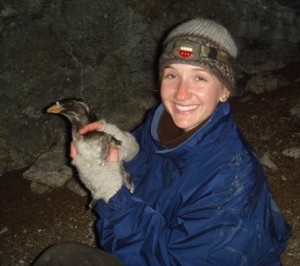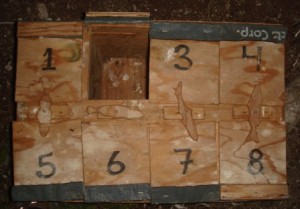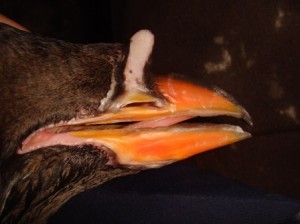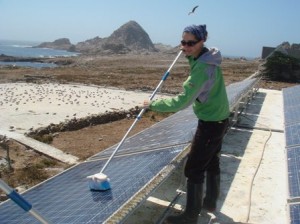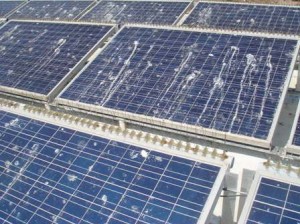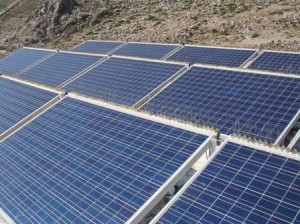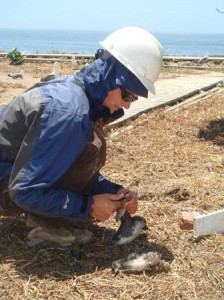So, last night ended our four-night run of rhino netting. Now, we have six nights off, and then the whole process starts again. As I mentioned before, we rotate jobs when netting rhinos, and the available jobs are fish person, bird person, and processing person. Last night, I was a processing person.
Processing the birds pretty much just means taking a lot of data on them, and banding them if they are unbanded. Annie and I processed last night, so we sat some distance away from the net, and waited for the bird people to bring us birds.
When someone brought us a bird, we would have to hold it in the right way, so that it remained relatively calm while we took a bunch of data. In most of the pictures you’ve seen of me with birds, I’m using what’s called Bander’s Grip, where you essentially put your first finger and middle finger around the birds neck. For the rhinos, we hold them up against our bodies in a modified banders grip that covers their eyes. You can actually feel them blinking against your fingers the whole time you’re holding them, it’s kind of weird.
Often, processing the birds is a slower procedure than catching the birds, and to fix that problem, we use what we call the Rhino Cubby. Birds that are in line to be processed are simply placed in these tiny cubbies, and wait there until we can pull them out. It’s amazing, because the cubbies are really small and the birds are pretty big, but often, when we put them in the cubby head first, they also come out head first, ready to bite you! I don’t know how they maneuver around so much in that tiny box, but you have to be ready to grab them, with no hesitation, or you’ll get bit, like I did.
Rhinocerous Auklets are so named because of the horn they have on their bill, which places them in a group of birds called the Tubenoses (Ashy Storm Petrels are tubenoses as well). When processing the birds, we meausre their bill depth and wing cord (sort of the length of the wing), and we also check for a brood patch, a patch of bare or downy skin beneath their breast feathers that indicates whether or not they are currently incubating an egg. We also weigh the bird, by placing them in a bag, and finally band them if necessary.
Rhinos are alcids, a group of birds with a very recognizable style of flying. They use their wings to swim underwater, but as a result, their wings are different from those of birds that fly all the time. Because of this, they have to maintain a very fast-paced wing beat to even fly, and they have a really hard time getting off the ground and into the sky in the first place. All this means that we can’t simply put the rhinos down, or hold them out in our arms and expect them to fly away when we’re done processing them. To fix this problem, we have to throw them, literally. When all the data has been collected on a rhino, you carry it to a high point, and throw it straight into the air, often squatting to get more leverage. The higher you can throw a rhino, the better, and the better chance it will have of successfully starting to fly before it hits the ground. Kind of nervewracking, I thought!
Rhino netting went fairly fast last night, and so did fish ID, and everyone collapsed because it’s been such an intense four days. Today, Sunday, we got to have brunch! Everyone met back at the house at 11 o’clock, and each person prepared a dish. The main dish for today was crepes, both sweet and savory. For the sweet crepes we had fried bananas and nutella (SO good), and for the savory crepes we had a spinach/mushroom/feta filling. Yummy. We also had scrambled eggs and a freshly-cut pineapple.
After brunch, I went out with Caitie to do the daily chick checks, and then, because it was such a beautiful, fairly warm, not too breezy day, we got to go up on the roof of the Power House and clean the solar panels.
The power house is a building on the island where we literally keep all the power. On its roof are the solar panels, and inside, you can find all of the batteries for storing the solar power, as well as all of the generators for the crane and other electrical equipment on the island.
On the roof, there are sixteen solar panels, and, as you can imagine, they get pretty dirty during seabird season, and it’s important for us to keep them clean so they run as efficiently as possible.
Here’s some before and after shots:
I think we did a pretty good job, and it was actually pretty fun!
Finally, I’ll end with a note about what we do with dead things on the island, because I found quite a few dead birds while I was walking around today. For the most part, we don’t worry about dead chicks, because they are incredibly numerous. Gulls will often kill and eat other gull chicks, as well as the chicks of other species.
If a bird is banded, even if it is a chick, we will take the band off (sometimes you have to cut the leg off to do this), and take the band back to the house. All dead birds that are found have their primary feathers clipped or cut, to tell the other people on the island that that dead bird has already been found.
At night, during the journal (which I’ll write about later), we record all the dead birds found that day.
For the most part, dead birds on the island are either killed by gulls or Peregrine Falcons. With gulls, however, it is increasingly common to find gulls that died from botulism, which they get from foraging in dumps, etc. Bot gulls are literally dead right where they stood, there are no marks or injuries on their bodies. Very sad.
Well, dinner’s almost ready, so I’m going to go.
Best,
Eleanor

